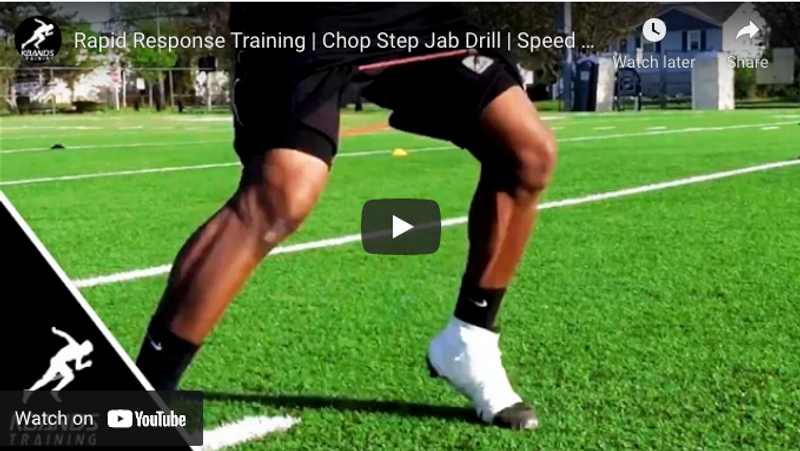Rapid Response Training | Chop Step Jab Drill | Speed Training
Athletes are all about speed. It’s why the stopwatch was invented. It’s what separates the weekend warriors from the rising stars. Speed is the elusive quality in elite athletes we assumed was entirely genetic, however we were wrong. The secret that all high performance movers share is rapid response training.
Rapid response training is all about getting all of your muscle fibers working together as quickly as possible. Sure there is the genetic component where some people are born with a higher percentage of fast-twitch muscle fibers, however if a person trains their neurons to fire a higher percentage of their fibers quicker, it doesn’t matter what the genetically blessed have going for them. In short, we can out-train our genetic shortcomings and rapid response training is how to do it.
Chop Step Jab Drill
The Chop Step Jab Drill is designed to be used with a set of Kbands, and the reason for this comes from the very nature of the drill. Kbands teach your body to work harder at the very onset of any movement, and this is what speed training is all about. With a set of Kbands securely in place begin the standard Chop Step Drill. Have your legs shoulder width and pumping. It’s not a bad idea to do this drill in a gym the first few times. This will allow you to hear the taps of your feet as you pump your legs. If you hear squeaking, you’re dragging your feet. Fix this by completing the motion with each foot coming all the way off the ground.
This rapid response training is supposed to be an explosive drill so only plan on doing it for a total of 3-6 sets of about 10 seconds (or 10 yards) each. Take enough time to rest between sets so the burning subsides, and you will feel the burn.
For the first set focus on only jabbing the right foot out every few chop steps. As with all speed training we are teaching our neural network as well as our muscles, so make sure to do the drill with control and coordination. During the next set use the left leg. For the third and every subsequent drill, alternate legs throughout the drill - again remember to be in control, lift the feet all the way off the ground, and go faster.
Speed Training is About Going Faster
This should go without saying, but it’s easy to forget as we get tired - Go Faster! You can always go faster than you are, so before you begin the drill tell yourself “go faster”. When you hit the 3 second mark, tell yourself “go faster”. Do this again at the 6 second mark and finish strong. Rapid Response Training only works if we expend maximum effort for the entire 10 sec/10 yards.
If you find yourself getting too tired to finish a set at your maximum speed then the drill is over. Don’t consider this a failure, rather a milestone. Next time you hit this drill go for a faster speed and one more set.
Why does Rapid Response Training Work?
Speed training is all about high percentage muscle incorporation, and coordinating your neurons with your muscles. What does this mean? The easy way to think of it is this: when a person goes out to run they generally start a slow jog and work into a rhythm going faster until they hit their goal pace. The body is made for cardio, and so it is as lazy as it can be. This is generally good. This laziness allows for a longer run without draining our energy reserves. The body accomplishes this by only engaging the exact percentage of muscle fibers it needs to accomplish the work. But what if you want to go faster?
To go faster the body bypasses its reserve settings and dumps energy into the muscle as fast as it can - meaning it burns the nearby energy instead of waiting for oxygen from the blood. This is the reason Rapid Response Training and all Speed Drills can only be 10-30 seconds long. By training at maximum effort, we empty all of the energy reserves the muscles have stored. Beyond this time the body has burned the local energy and it must wait for the oxygen.
Your body does not want to work so inefficiently, so it must be trained. By performing Rapid Response Training we can teach our bodies to tap that energy reserve quicker, incorporate a higher percentage of the muscle earlier, and coordinate our movements at a faster rate. The byproduct of this training is explosive speed, quicker cuts, faster recovery from lactic acid buildup, and an overall faster athlete.
Rapid Response Recovery
We’ve already discovered that Rapid Response Training is harder on the body’s metabolic processes (energy reserves and waste disposal). So it is important to take care of it after intense speed training. This means devoting time to fully stretch each muscle that felt the burn, in this instance the quads and calves should be high on the list. By stretching these muscles we encourage blood flow, lactic acid removal, and a refueling of those spent reserves. For a full list of our recovery stretches go to our Muscle Recovery and Stretching page, and while you’re looking around, grab the Kbands Recovery Foam Roller, you’ll thank me in the morning.

